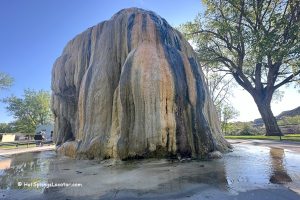
• Grand Prismatic Spring is the largest hot spring in the U.S. and the third-largest in the world
Grand Prismatic Spring is one of the top must-visit spots in Yellowstone National Park. The spring is known for its vivid colors and massive size, making it one of the most popular attractions in the park.
Grand Prismatic is also Yellowstone's most photographed thermal feature. And this is for a very good reason. Let us talk about what makes this hot spring so unique.
Grand Prismatic is the Largest Hot Spring in the U.S.
Grand Prismatic Spring is more than just a pretty sight. It is the largest hot spring in the United States and the third-largest in the world.
Here are some of the Grand Prismatic Spring facts:
- 370 feet (113 m) across, which is bigger than a football field;
- 121 feet (37 m) deep, which is deeper than a 10-story building;
- Contributes 560 gallons (2,120 liters) of water per minute to the nearby Firehole River.
The water in the spring is heated by magma from an active supervolcano underneath Yellowstone. Its temperature can reach 160°F (71°C). This is too hot for most forms of life, except for some fascinating microorganisms that took their residence there.
A Rainbow of Colors
Grand Prismatic Spring is well-known for its vibrant, rainbow-like colors, which are created by a combination of extreme temperatures and unique microorganisms:
Blue: In the deepest and hottest water, with temperatures of 180°F (82°C) and higher, no organisms can survive. The intense blue color comes from sunlight scattering in the clear, sterile water.
Green: As the water temperature decreases to 165°F (74°C) and below, cyanobacteria and other microbes thrive. The green tone results from a mix of chlorophyll and carotenoids.
Yellow and orange bands: In cooler waters below 150°F (65°C), thermophilic microorganisms produce carotenoid pigments, creating vibrant yellow and orange hues. These colors form in areas where the water is cooler than the center but still quite warm.

What Makes It So Unique?
The Grand Prismatic Spring is not just pretty. It is rare. The spring is part of Yellowstone's hydrothermal system, which includes geysers, hot springs, and mud pots. This system is fueled by the Yellowstone Caldera, one of the world's largest active volcanoes.
Here are a few fascinating facts about the Grand Prismatic Spring.
- The spring is part of the Midway Geyser Basin. Grand Prismatic's basin neighbors include the Excelsior Geyser Crater, Turquoise Pool, and Opal Pool.
- The spring's heat-loving microbes have helped scientists make remarkable discoveries, such as PCR testing for DNA, and contributed to the research of life on other planets.
- The Grand Prismatic Spring was first described in 1839 by trappers and later studied by the Hayden Geological Survey in 1871. It got its name because the spring’s colors look like those of a prism.
The size, color, and scientific importance make the Grand Prismatic Spring one of Yellowstone's top must-see places. It is truly one of a kind!
Plan Your Visit
Here are a few tips to make the most of your trip.
- Choose your timing wisely: The best time to visit is early morning or late afternoon due to fewer visitors and better photo lighting.
- Take the boardwalk loop: This path takes you straight to the spring. You will feel the heat rising off the water and see the colors up close.
- Hike the Fairy Falls Trail: Take this short trail to an overlook for a bird's-eye view. From here, you can see the entire spring and its rainbow bands.
- What to bring: A camera, comfortable shoes, and your sense of adventure.
- Do not get lost: The Midway Geyser Basin is located near the West Entrance of Yellowstone, about 25 miles from Old Faithful Geyser.
Important safety tip! Stay on the trails and boardwalks. The ground around the spring is fragile, and the water WILL cause severe burns.
Keep a safe distance and always supervise children and pets.
Do NOT throw anything into the water under any circumstances! Such behavior already destroyed several ecosystems in Yellowstone alone.

Beyond Grand Prismatic Spring: Other Adventures
Grand Prismatic Spring is part of the Midway Geyser Basin, full of geothermal wonders. While you are there, make sure you do not miss:
- Excelsior Geyser Crater: Once an erupting geyser, a massive, steaming pool pours boiling water into the Firehole River.
- Turquoise Pool: This serene hot spring glows with stunning blue-green water.
- Opal Pool: Known for its shimmering, opalescent colors that change with the light.
And this is just the Grand Prismatic's basin. Yellowstone National Park is an enormous collection of geographically, geologically, and biologically vibrant areas going far beyond the incredible magic of hot springs!
Even if you decide to make your trip water-themed, you can easily assign a week to focus on good old H2O and its multiple variations. Yellowstone is home to the largest concentration of hydrothermal features in the world, among which are:
- Old Faithful Geyser: Watch one of the world’s most famous geysers erupt with clockwork precision.
- Mud Pots: The bubbling, gurgling mud pools are nature’s version of a witch’s cauldron.
- Fumaroles: The steam vents release powerful geothermal heat from deep underground.
Beyond the geothermal features, Yellowstone offers breathtaking landscapes, from towering mountains to winding rivers and lush forests.
You can also watch (only watch, do not pet!) wildlife like bison, elk, wolves, and bears.
If you do want to soak in the spring (without being severely burned), head to Yellowstone Hot Springs, Bozeman Hot Springs, or Chico Hot Springs for a soothing geothermal bathing.
More Adventures








